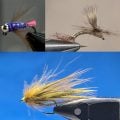How to Tie a BWO Size 18
Producer: tightlinevideo
Late fall in many parts of the United States means Blue-winged Olive hatches, particularly on overcast days. This size 18 BWO takes advantage of a couple of new fly tying materials, both of which help the pattern to ride on the water’s surface for extended periods of time.
The fly starts with a size 18 Fulling Mill 5050 barbless dry fly hook but the pattern is easily tied down to even a size 24. I begin by getting the hook firmly secured in the jaws of my tying vise, which I’ve equipped with a brand new head from Regal Vise. The unique hooked jaws allow for incredible access to small hooks. Furthermore, moving the hook rearward in the jaws helps to prevent delicate threads from breaking on the hook point – and also allows you to take wraps well down into the hook bend, which is particularly valuable when tying on curved, scud-type hooks. For now, I’m going to move the hook forward into a more normal position in the jaws.
For thread, I’ve loaded a bobbin with a spool of Semperfli 12/0 Classic Waxed in an olive-dun color. For its small diameter, this thread is remarkably strong, and I like to tie this pattern with a good bit of thread tension. Get the thread started on the hook shank, leaving a little space behind the back edge of the hook eye and, after taking a few wraps rearward, snip off the excess tag.
Medium pardo Coq de Leon fibers are used for the tail of the fly, 4 or 5 fibers are all that’s needed. Strip them free from the stem by bringing them down perpendicular to it, then pulling the stem away. If the butts are aligned, the tips generally are too.
Measure to form a tail a little more than a hook shank in length, then transfer that measurement rearward to the start of the hook bend. Using a pinch wrap, begin securing the fibers to the top of the shank. As you take thread wraps rearward, pull slightly up and toward you on the fibers. This will prevent the wraps of tying thread from pushing them to the far side of the hook, and should keep them centered right on top of the shank. Bind them down all the way to the start of the hook bend. Then, return your thread forward to the initial tie-in point and lift the butt ends up before trimming them off close.
Fulling Mill’s new synthetic Ultra Dry Yarn is used for the comparadun-like wing of the fly. Snip a single strand free from the hank then fold one end over to form a loop, about a half-inch in length. Place the loop on top of the hook shank, above your tying thread and, here too, use a pinch wrap to begin securing it. Take a few wraps rearward to further bind the material down, then wrap forward, pull the material back and jam a few wraps around just the shank in front of the wing.
Return your tying thread back behind the wing and a little ways down the shank. Lift the excess yarn up and snip it off at a shallow angle. The remainder of the material can be used to tie multiple flies. Continue taking rearward wraps of tying thread to cover up the snipped off butt ends of the yarn, then leave your thread hanging at about the midpoint of the hook shank.
Kapok dubbing, here olive-covered from Semperfli, is super floaty stuff and, back in the day, was even used in PFD’s – what we used to call life jackets. As I understand it, the material comes from a plant, and as you can see here, is incredibly fine. It’s important to pull a small clump apart several times to really separate and orient the fibers. They should look about like this before you begin twisting them on your tying thread.
Use the Kapok to create an extremely slender noodle on your tying thread. It’s truly amazing just how fine a dubbing noodle you can produce with this stuff, particularly if you get the fibers aligned roughly parallel to your tying thread. It’s almost like simply coloring the thread with dubbing. Once you’ve established a noodle about 2” in length, begin taking nice, tight wraps with it so the dubbing begins right at the base of the tail. As you take touching wraps forward, notice how the slender noodle produces a rather natural-looking, segmented and tapered abdomen on the fly.
If you run out of dubbing, which is easy to do, go back to the packet, retrieve another small amount, tease the fibers apart as before, and use the material to create an even smaller noodle on your tying thread. You want this noodle substantial enough to brace the wing, both fore and aft, into an upright position. Ideally try to get to bare tying thread right at the back edge of the hook eye.
Reach for your whip finish tool and use it to do a 4 or 5 turn whip finish, seat the knot well and snip or cut your tying thread free. I like to pull down on either leg of the loop to spread the material out a bit, down the sides of the fly. I’ll then gently pull the loop up and snip it off to form a wing, about a hook shank in length. Err on the side of smaller rather than larger here, as you don’t want this fly to be top heavy. You can see in this view how the wing should spread out in a similar manner to that of a comparadun.
And that’s all there is to it. For a fly this small, it’s quite easy to tie, presents well and, because of the materials used, floats like a champ but, just like most dry flies, does require some assistance from either a dry or liquid floatant after prolonged use.
How to Tie a BWO Parachute - Size 24
How to Tie a Caddis Emerger











